Advertisement
If you have a new account but are having problems posting or verifying your account, please email us on hello@boards.ie for help. Thanks :)
Hello all! Please ensure that you are posting a new thread or question in the appropriate forum. The Feedback forum is overwhelmed with questions that are having to be moved elsewhere. If you need help to verify your account contact hello@boards.ie
Hi all! We have been experiencing an issue on site where threads have been missing the latest postings. The platform host Vanilla are working on this issue. A workaround that has been used by some is to navigate back from 1 to 10+ pages to re-sync the thread and this will then show the latest posts. Thanks, Mike.
Hi there,
There is an issue with role permissions that is being worked on at the moment.
If you are having trouble with access or permissions on regional forums please post here to get access: https://www.boards.ie/discussion/2058365403/you-do-not-have-permission-for-that#latest
There is an issue with role permissions that is being worked on at the moment.
If you are having trouble with access or permissions on regional forums please post here to get access: https://www.boards.ie/discussion/2058365403/you-do-not-have-permission-for-that#latest
My Plan to Achieve Energy Freedom - The Road to Zero Energy Bills
Comments
-
As part of Step 5 on the journey to energy freedom, I installed a wood burning stove with a back boiler to reduce our dependence on natural gas for heating the house (and hopefully eventually remove it completely). That was 18 months ago, and so I wanted to calculate how much money it has saved in its first year and a half of operation, and how my estimate stacked up. So here it is: The Wood Stove One Year On: The Dent in the Gas Bill.
The stove cost €4000 to install, and I had estimated that the stove would pay for itself in 4.22 years, and save €8,288 in gas costs over the following 10 years, eliminating just over three and a half thousand kilos of CO2 a year while it's at it. Over the past year, I've been reading the gas meter once a month and tracking the usage of the fire to see how much the wood stove has eaten into the gas consumption. The answer is: very much! I'm very happy with the picture over the last year. Here is the overall heating consumption of our house. The area in green was met by the wood stove, and the blue area was gas consumption. The dotted line tracks the cumulative amount of money we've saved on our gas bill as time goes on: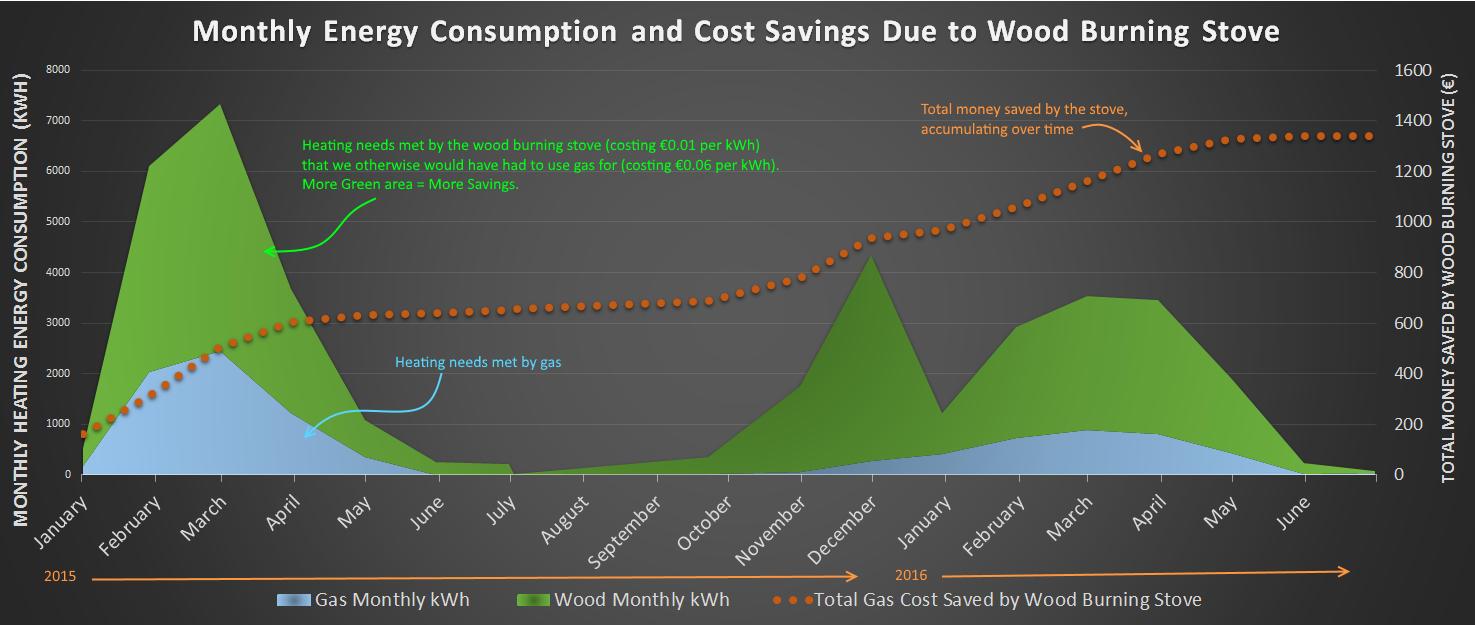
The total gas cost saved in 2015 was €968.90. That means the stove is on course to pay for itself in 4.22 years, and then return a profit of €8,288 over the following 10 years. Over all, we consumed about 20% more heat than I had anticipated, mainly because of an unusually cold February and March last year, but the wood stove really eat into the gas consumption. In the 18 months since it's installation, it's generated 33,480kWh of heat that we otherwise would have had to burn gas to generate. In that time, we consumed 9,891kWh of gas. Removing this last ~6,500kWh of gas costs per year is the next target.
There are some interesting observations in terms of how we use the wood stove. It has different strengths and weaknesses to the gas boiler - when we light the wood stove, it heats up the house over the course of about an hour and keeps giving out heat to the radiators around the house after its last fed with wood for about three hours. That means that because some heat is escaping out of the building, if it's very cold at night, the gas boiler may need to come on around 4am-5am as the temperature of the house drops. This essentially represents the gas portion of our energy consumption above. However, when I noticed this, I started thinking about ways to reduce the need to use the gas boiler at night.
What I arrived at, was by making a few observations, figuring out how much heat escapes from the house per hour for a given outside temperature. Once I had figured this out, I could check what the weather forecast was for the night, and work out what temperature we needed to heat the house to with the wood stove before going to bed such that the house would be exactly what temperature we wanted to wake up to. This generally works very well. Something that looks like this: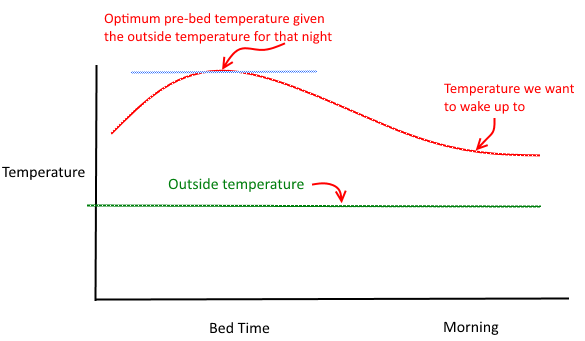
I'm lucky in that I have some land from which I can get free wood, so the cost per kWh of wood worked out around €0.01 / kWh, compared to €0.09 / kWh for gas. I've also planted some trees to be harvested in the future for firewood (future post coming - planting trees on land you have turns out to be a very good financial investment, a cool hobby and a way to offset your lifetime carbon footprint). The €0.01 per kWh is comprised of the transport and processing costs. The cost of gas in Ireland includes a Carbon tax, which is likely to increase in the future, which would increase the savings of using wood.
I had a lot of fun during the year preparing wood - I mostly used an electric chainsaw, for which the maintenance is very little effort. It would of course have been possible just to buy a cubic metre of wood each month but the fire is much more satisfying when you have done the labour yourself. It turns out that bungee chords from a bike are a great way to hold wood in place safely while chopping it up into fire logs.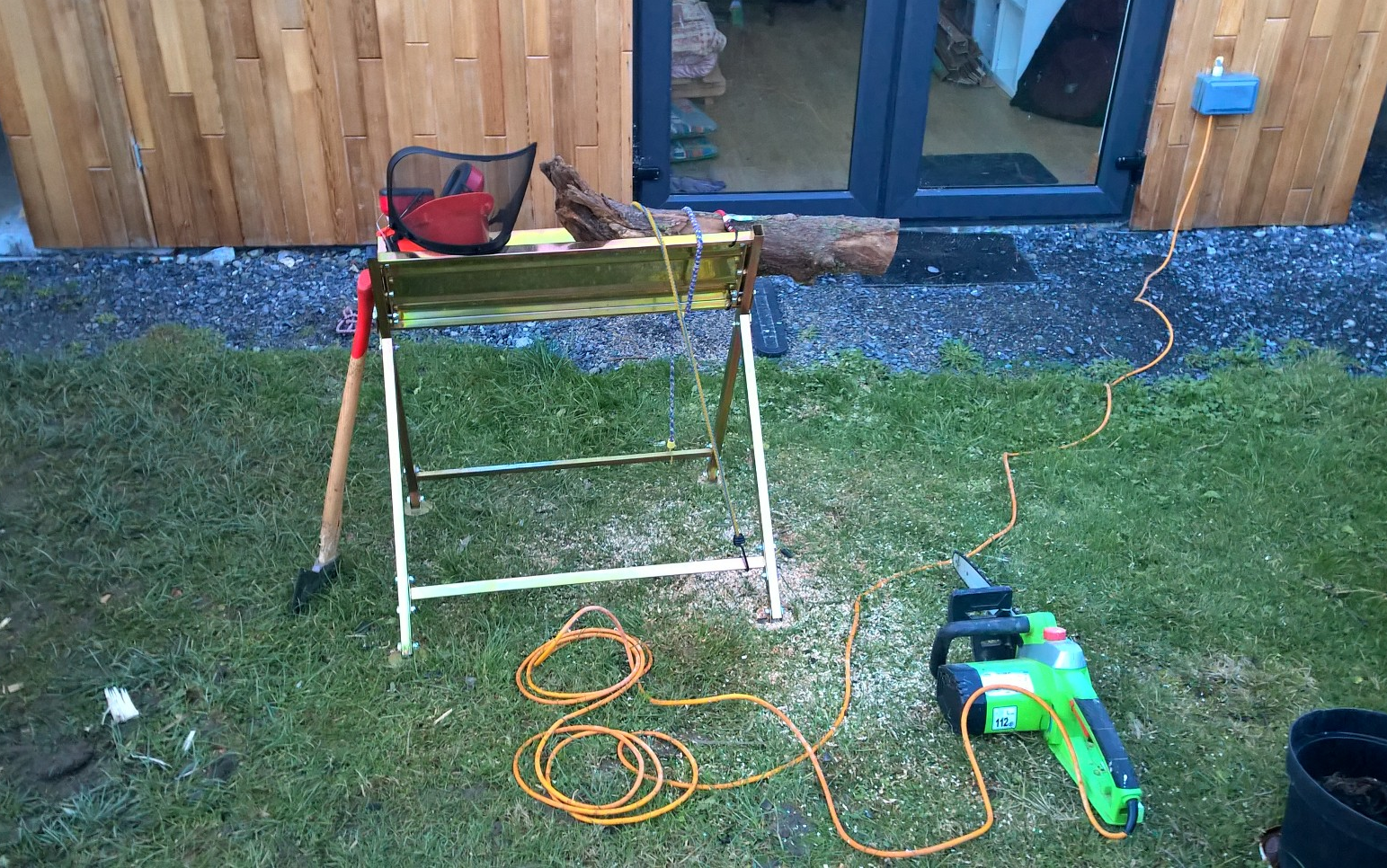
As I've mentioned, the next step in the process is removing the remaining gas consumption entirely, and for that I intend on installing a heat pump. But this is a fantastic start - it's removed about 75%-80% of our heating costs. In the same way that the electric car removed about 85% of our transport costs. These two investments alone are now saving us €3,923.7 per year, which is literally paying off our mortgage. I really feel like we're getting off the hamster wheel of earning and paying tax on money just to waste a significant portion of it on incredibly inefficient transport and heating solutions.
This is tied with switching to an electric car as my favourite energy investment so far. Apart from the pretty decent return of 7.7% per anum, which is quite a bit better than any other asset investments I can find, it has a huge quality of life factor - sitting by a fire in winter is a fantastic experience that has brought the family together.0 -
Where are you buying your gas?
Most suppliers are under 5c/kWh now.
Also, you can't say a car is giving you a return of 7.7% because you're not factoring in depreciation.
When the car has "paid for itself" through savings, it's likely to be worthless so at that point you've achieved a 0% return.0 -
You can't say a car is giving you a return of [4.1%] because you're not factoring in depreciation.When the car has "paid for itself" through savings, it's likely to be worthless so at that point you've achieved a 0% return.
I certainly have included depreciation! I'm using the standard comparison-to-baseline investment calculation. e.g. Compare a possible investment like switching to an electric car versus the baseline of sticking with a petrol car. This is pretty standard as a way to compare efficiency / cost reduction investments versus dividend/appreciation investments.
For the Electric Car, I assumed a 100% depreciation of the car and a replacement battery over the ten years, which was a depreciation of €16,000 + €5,000 = €21,000. The yearly savings of the electric over the petrol car are €2,964.8 which means a ten year saving of €29,648. That means the final return over the baseline of driving a petrol car is €29,648, minus the depreciation costs of €21,000 = a net return of €8,584. €8,584 / €21,000 = 40.8%, over 10 years giving a 4.1% ROI.
I took the most conservative depreciation as possible (100%) because if the numbers stack up at that, they will stack up for any eventuality. I actually think the depreciation will be a little better - when the capacity of the first battery drops to ~18kWh, I hope to take it out, install an inverter, and use it to soak up Solar PV and power the house in the evenings. Tesla Powerwalls are about €6,000 for 6kWh at the moment. Assuming they triple in capacity for the same price in 5 years, that puts the value of the 18kWh battery at about €6,000 at that point. Which would put the depreciation of the car at €15,000, meaning it returns a yearly ROI of 5.7%. But it's not clear if that will be possible, so I didn't include that potential upside in the calculation.
Thanks for questions like these. If you didn't see what I had done, then others may have also so hopefully this post clarifies how it was calculated.0 -
Genuinely Love this thread. 2 quick questions.
How come the outside temp is a flat line in the graph above, should it not raise and fall for different hours?
Also, why is it "optimal temp for that given night" is this temp not the exact same every night regardless of outside temperature?
May have posted it already, but if you don't mind sharing, can I ask what you studied in college or what your field of occupation is? Just generally interested as you seem to be made for this kind of thing!!!0 -
Thanks - appreciate it!delaney001 wrote: »Genuinely Love this thread. 2 quick questions.
Yep - it does rise and fall, but this makes the maths (and the chart) more complicated, so I just put in a solid line to illustrate the point. I actually have part of a post on figuring this out because it was interesting to me. I started recording the temperature of the house (our baby monitor has a thermometer) when going to bed and the same in the morning, and also recording the average outside temperature overnight. With this, I could work out the difference in temperature between the house and the outside, and how long it was between the night and morning readings. That meant I could work out how many degrees C of heat leaks out of the house per degree of difference per hour. And knowing that means I could look at the weather forecast, see what temperature it would be that night, and know how hot the house needs to be before going to bed to be warm enough in the morning. For reference, our house looses 0.04C per hour per degree of difference with the outside. So if it's 19C in the house going to bed at 11pm it's 10C outside, and we get up at 7am, that means the house will be 8 hours * 9 degrees of difference * 0.04C = 2.88C cooler, or 16.12C waking up. I wrote the formula into an Excel spreadsheet, so it does all the maths and just says what temperature to heat the house to before going to bed.delaney001 wrote: »How come the outside temp is a flat line in the graph above, should it not raise and fall for different hours?
Also, why is it "optimal temp for that given night" is this temp not the exact same every night regardless of outside temperature?
I don't have any formal education in renewable energy or sustainability. I really just read one book which allowed everything to fall into place, and everything in this thread so far is pretty much based on it: Sustainable Energy Without the Hot Air by David MacKay. The whole book is published for free as a PDF. He shows how to equate everything to one unit - kWh, and so compare all forms of transport, heating, power generation, and figure out a road map to getting to cheap, clean sources of energy.delaney001 wrote: »May have posted it already, but if you don't mind sharing, can I ask what you studied in college or what your field of occupation is? Just generally interested as you seem to be made for this kind of thing!!!
My background is in Engineering and IT, and that may help, but I really think moving to renewable energy technologies is a no brainier whether you're interested in the money savings they achieve, or whether you're interested in the fact that they are more sustainable than fossil fuels. On the money side of things, we are lucky enough to be around at a time when a confluence of technologies is giving us the option of efficiency and cheap, distributed generation. When I started looking into the path of getting off the hamster wheel of energy costs, I was surprised that (1) it was so easy to do and (2) that so few people had done so already. Hopefully this thread will make it easy for people to reap the same benefits. I think the main thing is that many people don't think to see efficiency (e.g. bills avoided) as an investment. They're happy to invest money in a bank with a 2% return, when they could be getting 5% ROI on those savings by insulating, installing PV or a heat pump.
On the environmental side of things, it really annoys me that fossil fuel and agricultural vested interested have successfully manipulated us into spending vast amounts of money on fuels which will greatly damage the lives of our children. Diesel engines emit asbestos-like micro particles which are known to increase the occupants' (particularly children's) risk of lung cancer, and yet we have more diesel cars on our roads than any other type. Fossil fuel and agricultural interests have led a successful misinformation campaign, similar to the tobacco industry as it became clear that smoking caused cancer, to delay regulatory changes to prevent dangerous climate change - June 2016 marked an increase of 0.9C above pre-industrial times and the artic has now lost 1 trillion tonnes of ice. They are literally lining their pockets at our expense. I feel I owe it to my children to do what I can to change the situation. Therein lies my motivation.
Happily, advances in technology now provide us with a beneficial confluence - there is a greater financial return in freeing ourselves from energy costs than any other low risk financial investment. It also gives us an opportunity to create momentum towards the only future our children will likely to be able to inhibit with any reasonable quality of life. In summary.. read the book above, and if you feel like it, give it a go.0 -
I had a look at your figures on the first page regarding the leaf.
Firstly, how you were managing to spend €1100 a year maintaining an Almera is completely beyond me.
Furthermore, you haven't allowed for any maintenance costs at all on the leaf, no tyres, suspension components or servicing. These are likely to add up to at least (200+50+100)=€350 a year or so conservatively.
Also, a 15 year old Almera was probably worth less than €1000, so for a fair comparision you should be including the cost of credit for the €16,000 used to buy the Leaf. This should be factored at the cost of the most expensive debt that you currently carry. So if you used a loan for the Leaf or even if you only have a mortgage at 3%, you should be allowing for €450 a year for the cost of capital.
Finally, your battery will not be worth €6000 in 5 years time, today it's worth anything between €1000 and £2500 based on what others are buying them for in the 2nd hand market. In 5 years time it will have degraded to about 75% of it's original capacity or less (already down to 90%) and is unlikely to be worth €1000.0 -
your battery will not be worth €6000 in 5 years time, today it's worth anything between €1000 and £2500 based on what others are buying them for in the 2nd hand market. In 5 years time it will have degraded to about 75% of it's original capacity or less (already down to 90%) and is unlikely to be worth €1000.
Earlier this year I sold a 5 year old Nissan Leaf with 80,000km on the clock.
Nissan tested the battery at 83%. This was the Gen 1 Leaf that had the inferior battery, so Gen 1.5 cars are doing better still. I would guess that gen 1 cars will last for up to 12 years before they hit 75%.0 -
There's a thread on SpeakEV.com where user's are plotting their battery degradation vs age and distance driven.
It shows no improvement whatsoever between Gen 1 & 2 batteries.
The 30kWh pack should do far better though.0 -
Indeed, the average maintenance cost in the three years leading up to when I switched to an electric car was €1104 per year. In 2012, the timing chain went. The clutch went in 2013, and the car failed the NCT twice in 2014 on exhaust emissions which needed a few trips to a mechanic. I am happy that an electric car contains none of these parts. Your point is fair on the servicing costs, however small, for the electric car. It's warrantied until 2019, so any major problems will be free up until that time. I've had it serviced once in the two years since getting it. I took it as a good sign that it was just a changing of the pollen filter in the AC and a grease of the door hinges that was charged for. On the other side of the equation, I allowed for charging the car exclusively at home. The public charging infrastructure has been free for longer than expected and has become quite well built out. We have done 55% of the charging of the car so far at public charge points, which has removed about €120 of costs. I'm sure that as electric cars become more ubiquities, this will stop, but it probably evens up the estimated costs until it does. I'll recalculate the figures at year 4 and see if the estimates were way off, but so far, they've been in the right order of magnitude.I had a look at your figures on the first page regarding the leaf. Firstly, how you were managing to spend €1100 a year maintaining an Almera is completely beyond me. Furthermore, you haven't allowed for any maintenance costs at all on the leaf, no tyres, suspension components or servicing. These are likely to add up to at least (200+50+100)=€350 a year or so conservatively.
The cost of capital is counted as an opportunity cost. As you say, I can either pay down the mortgage which removes interest costs, or I can buy a Leaf which reduces car running costs. In scenario 1, I can use the €16,000 to pay down the mortgage at 3% and in 10 years, that money is worth €16,000+€4,800 = €20,800.00 (interest payments on €16,000 @ 3% are €480 a year, which is €4,800 over the ten years). In scenario 2, I can buy a Leaf with the €16,000 and save €2,954.8 a year on running costs against my baseline (a petrol car), so in ten years, the €16,000 is worth €2,954.8 * 10 = €29,548.00 (assuming the car is worth €0, so including 100% depreciation).Also, a 15 year old Almera was probably worth less than €1000, so for a fair comparison you should be including the cost of credit for the €16,000 used to buy the Leaf. This should be factored at the cost of the most expensive debt that you currently carry. So if you used a loan for the Leaf or even if you only have a mortgage at 3%, you should be allowing for €450 a year for the cost of capital. Finally, your battery will not be worth €6000 in 5 years time, today it's worth anything between €1000 and £2500 based on what others are buying them for in the 2nd hand market. In 5 years time it will have degraded to about 75% of it's original capacity or less (already down to 90%) and is unlikely to be worth €1000.
I assumed the battery is worth €0 at the end of the 10 years in the calculations to cater for the worst case scenario. I assume 100% depreciation. However, I do hope that an inverter is available at that point to use the 12-18kWh to power the house, which coupled with a PV array, would be a good way to utilise all PV generation to power the house, and also achieve arbitrage between day / night rate, or real time electricity rates if they're available at that point.0 -
Advertisement
-
Solar PV now makes financial sense in Ireland.
I really don't like having to pay someone to burn coal and gas on my behalf in power plants like Money Point and in the midlands, so I can run my lights and appliances. It's really expensive, for one. Also, the price can change from one year to the next, and I don't like being at the mercy of oil, coal and gas markets. Finally, I feel guilty for the people who live near coal and turf power plants. They spew out some pretty awful stuff into the air that nearby residents have to breath. I'd much prefer to pay less for my electricity, and to be insulated against price changes.
As such, I've been watching the relentless march of Solar PV prices downwards for the last 4-5 years. 10 years ago, it only made sense to put solar in places like Australia. Lots of sun. In the last 3-4 years, Solar Panels became cheap enough that it's been flying across the US. Then a price war on Solar panels broke out between US and Chinese Manufactures. This, coupled with significant money going into PV research (a lot of which is coming from fossil fuel companies interestingly) has led the price of Solar PV to drop off a cliff, at the same time as their efficiency in overcast places like Ireland has increased to the point that it is a viable investment.
Wait But Why has a great article on Solar PV, and why he predicts it's only a matter of time before Solar + Battery Storage becomes so cheap that it will essentially run the world:
"The sun radiates more energy to the Earth in a couple hours than all of humanity consumes from all sources each year."
When I look at the cost of Solar panels over time, an obvious conclusion is: At some point, panels and associated equipment are going to be so cheap, that it will be significantly cheaper to install them than to purchase the equivalent electricity from the grid.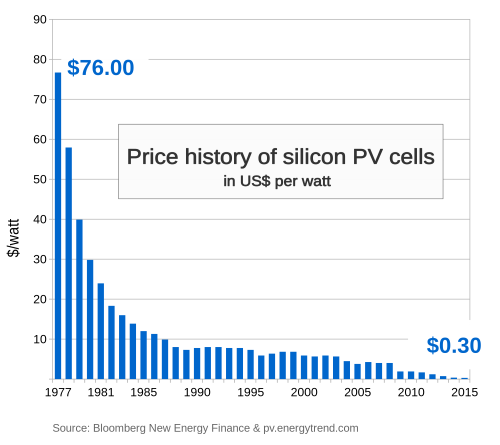
Another useful property of Solar is that it's a technology, not a fuel. Fuel based electricity has by and large increased over time with or ahead of inflation. This type of uncertainty is not something I want to be exposed to. Hence, this chart summarises the promise I see in solar for energy independence: I know exactly how much the electricity it generates will cost ten years from now. I have no idea how much grid electricity will cost, but it will probably cost a lot more than it does today.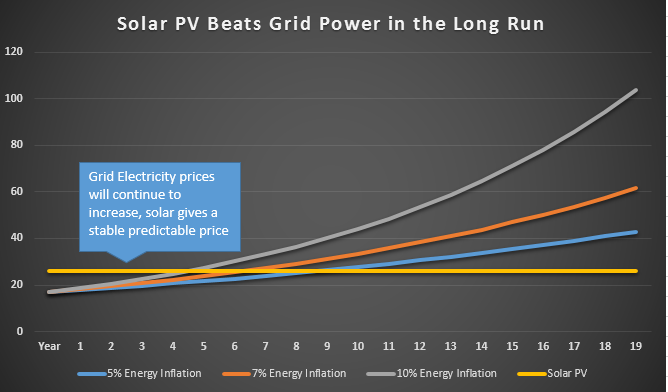
For predictions of how cheap solar will get in the coming years, see How cheap can solar get? Very cheap indeed, it seems.
I don't invest in things until they earn me more money than paying own my mortgage (e.g. it has to return 3.5% per anum). This point has arrived. By my calculations, Solar PV is now a no-brainer investment in Ireland. This post is about my planning towards installing Solar PV.
Getting an initial idea of what Solar PV might generate
We don't do anything blind here - let's figure out exactly what our options are, what the optimal Solar PV setup is for us, how much it will cost, and how much it will generate. Luckily, domestic solar PV is now big business, and there are some really useful tools to predict with good accuracy the cost, generation and payback for any solar PV setup based on the weather for any area of the world. HelioScope is a really useful web app which allows you to indicate where on a map you would put the panels on your roof, and it will work out the generation for each month of the year based on the local weather / sunshine information, the area covered with panels, and the type of equipment you select.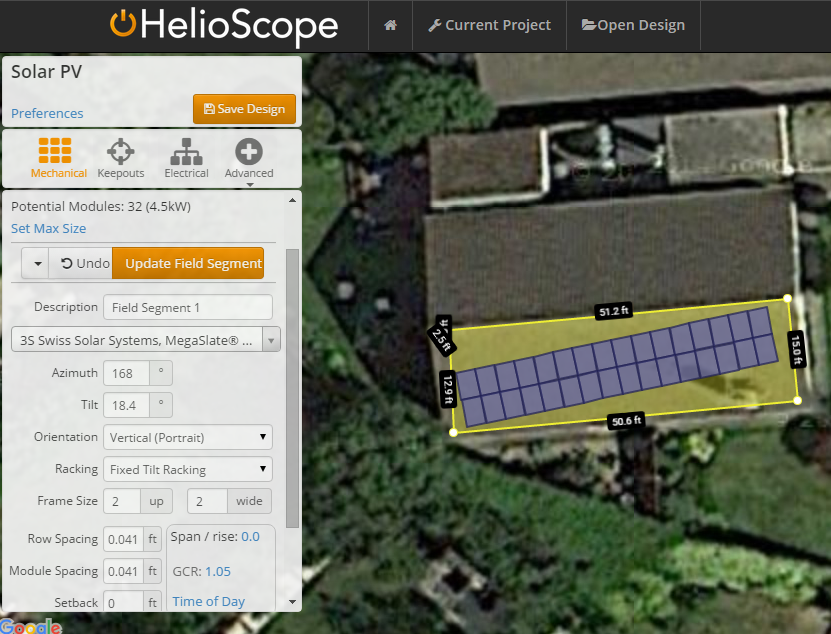
NREL in the US also hosts http://pvwatts.nrel.gov/pvwatts.php: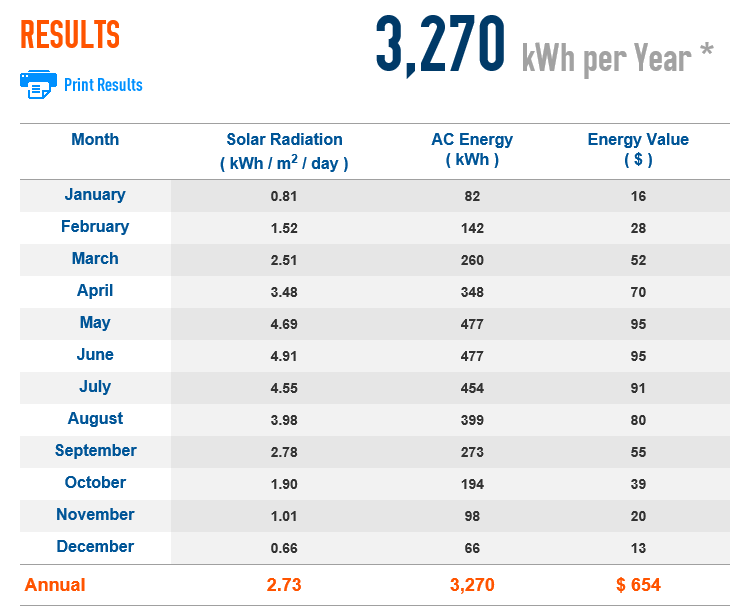
Time to generate my own power
Statistically (I guess), half of the houses in Ireland have a rear facing roof to the South or East. These houses can mostly just go ahead and install solar without any planning considerations. I am not one of these! The front of my house faces South, but there is an exemption from needing planning permission for a Solar PV array up to 12M^2 on the front of houses in Ireland. So that's a good start. With this, I can fit 7 Solar PV panels without planning permission. In the UK, when a Solar Feed in Tariff was introduced to encourage people to install Solar PV, the need for planning permission for any domestic system was removed. If that happens in Ireland, I can add further panels at that point. But that might be a while, and from an initial few quotes I've gotten from PV companies for the setup above, I'm seeing a return on investment of about 7.5% all things considered, so we're now passed the crucial ROI figure of paying down our mortgage (3.75%). The price of solar has fallen to a point where it is a better investment of my previous energy savings than paying down the mortgage or any other investment available (bank interest rates are ~1%, stock market perhaps 4-5% with high risk). As a logical investor - I will now install Solar PV.0 -
Great post, thank you,
What retail price are you getting per watt the lowest I can find is 1.1 euro per watt with shipping which for me is still not a good Return on investment (ROI).0 -
Solar PV now makes financial sense in Ireland.
Time to generate my own power
Statistically (I guess), half of the houses in Ireland have a rear facing roof to the South or East. These houses can mostly just go ahead and install solar without any planning considerations. I am not one of these! The front of my house faces South, but there is an exemption from needing planning permission for a Solar PV array up to 12M^2 on the front of houses in Ireland. So that's a good start. With this, I can fit 7 Solar PV panels without planning permission. In the UK, when a Solar Feed in Tariff was introduced to encourage people to install Solar PV, the need for planning permission for any domestic system was removed. If that happens in Ireland, I can add further panels at that point. But that might be a while, and from an initial few quotes I've gotten from PV companies for the setup above, I'm seeing a return on investment of about 7.5% all things considered, so we're now passed the crucial ROI figure of paying down our mortgage (3.75%). The price of solar has fallen to a point where it is a better investment of my previous energy savings than paying down the mortgage or any other investment available (bank interest rates are ~1%, stock market perhaps 4-5% with high risk). As a logical investor - I will now install Solar PV.
@Conor20
With all due respect Conor...thats a lot of copy and paste bs with capital B and capital S !!!
For a proper PV system to offset and do any kind of return to its owner,you will need minimum 8 panels x 250W each.Then an inverter for 2.5Kw generated power,installation kit,new dual feed electrical meter and not lastly,the rip-off charge of the installer(s).
I will say as cost at minimum €5,000 ex VAT.
If you do 10 units per day at .15c each,is €1.50 per day,€45 per month,€90 per bill + additional PSO and taxes,around €150 per bill.
In a good day and not like we had his fcuking weather lately,you can generate maxim 3-5 unit per day,from May to October. All the other days of the month, possible 1-3 units,just to keep inverter warm.
Now,please do the maths...
Im talking from years of doing the maths and now,waiting for the past 2 months with the panels in my living room because i cannot find someone to install it for me, unless i pay from €1.500. Again,do the maths...where are the fcuking savings !?? Most of the suppliers wants to sale at a cost that will attract you then kick you at installation.
IF i had to start again,i will not chose any type of fcuking renewables,as a DIY job.Not worth it,life is too short ! Someone(s) are destroying this planet right now so please i cannot take the carbon tax savings any more !
Have fun...0 -
Something was just not right with that post. It was like an advert. You saw right through it.
I am looking into this for heating water only with a simple setup ,
The most expensive thing to do in your house is heat water,
250 watt panels X 8
12 battery
12 volt heating element put in tank.
Controller
At less then a euro a watt it is getting close to this setup work with good ROI.0 -
If you're looking to heat water then heat the water, batteries make little or no sense.Something was just not right with that post. It was like an advert. You saw right through it.
I am looking into this for heating water only with a simple setup ,
The most expensive thing to do in your house is heat water,
250 watt panels X 8
12 battery
12 volt heating element put in tank.
Controller
At less then a euro a watt it is getting close to this setup work with good ROI.
Just install the panels on grid as normal and use a PV diverter to divert to a normal 230V immersion element.
The ROI will be higher this way as you will offset your consumption at the full retail value of the energy fed back to your supply.
Rolion, where are you located and do you have a slate or tiled roof?
Would you not consider installing them yourself, it's not all that difficult.
On ROI, I have a 4kW system (soon to be expanded).
It is oriented 1500W South and 2500W West roughly.
It generated €200 in it's first year in FIT payment from Electric Ireland and would have offset probably another €100 in self consumption.
Ballpark exported 2000kWh, imported 1000kWh, obviously self consumed the remainder of production.
Total annual bill about €250.
So essentially the FIT offsets all my consumption costs but I'm still paying the standing charges / PSO levy etc.
My total cost will be around €600/kW installed, however I did all the work myself and sourced everything in the UK using eBay etc extensively.0 -
If you're looking to heat water then heat the water, batteries make little or no sense.
Just install the panels on grid as normal and use a PV diverter to divert to a normal 230V immersion element.
The ROI will be higher this way as you will offset your consumption at the full retail value of the energy fed back to your supply.
I still like to keep it simple for maintenance and ROI, why convert back to AC with both cost and power loss for no reason. you can buy a 12 volt DC element for next to nothing add it to your hot water system or underfloor heating tank.
We have enough room for 4M X 3M area about 2KW in size.0 -
Advertisement
-
If you do a bit of research you'll find that what you propose won't work at all really.I still like to keep it simple for maintenance and ROI, why convert back to AC with both cost and power loss for no reason. you can buy a 12 volt DC element for next to nothing add it to your hot water system or underfloor heating tank.
We have enough room for 4M X 3M area about 2KW in size.
1. 2000W @ 12v is going to be over 150A.
The cable required if the PV is any distance at all from the tank will be colossal.
2. The PV won't work at its maximum power point if it's direct connected to the element and the majority of the time will produce nothing at all.
3. A tank provides storage in thermal form, what's the point in adding expensive and short lived batteries to the equation.
4. You convert back to AC so you can use the panels to create high value AC electricity instead of low value heat.0 -
wow interesting, thank you0
-
@Conor20: With all due respect Conor...thats a lot of copy and paste bs with capital B and capital S !!!.. Now,please do the maths... Im talking from years of doing the maths and now,waiting for the past 2 months with the panels in my living room because i cannot find someone to install it for me, unless i pay from €1.500.
I feel like we're going in two different directions here - a DIY project versus a fully installed and warrantied installation, which is what I'm looking for. All I do is maths. I want to have little or no uncertainly for my investment. I've used freely available software to predict how much a solar PV setup will generate on my roof. I've gotten quotes for that setup from Solar PV suppliers. I calculate that the system will save more money than it costs over it's warrantied lifetime. As a result I will have it installed and then measure the results.Great post, thank you. What retail price are you getting per watt the lowest I can find is 1.1 euro per watt with shipping which for me is still not a good Return on investment (ROI).
Calculating the €/kWh rather than the €/watt potential makes more sense to me, so the investment can be normalised back to the money the PV array will generate over it's lifetime - What it generates is more important to me that what it's potential is. To get that, I use the prediction software to predict the yearly yield of the PV setup based on the sunshine records of my area, and extrapolate that over the 25 year performance warranty of the system. That gives me a predicted number of kWh generated over it's lifetime (say, 47,500kWh for a 2kWp system over 25 years). I know how much the system costs (say, €4,500 now plus €1,000 for an inverter replacement down the road = €5,500 in total), which would give €5,500 / 47,500kWh = €0.11 per kWh. Our day rate is currently about €0.18 / kWh including VAT, Carbon Charge and PSO. It'll likely go up in the future. These are all just illustrative for now, but that's the idea. I've been watching that €/kWh for a while, and I finally feel it's at the point where I'm happy to install a PV array. I'm not going to hang about, I'll hopefully get it installed over the 1-2 months before the Home Renovation Scheme VAT Refund expires, and will have some initial generation results in 6 months or so.0 -
What is your usage pattern ConorB?
For me, PV does not make sense just yet, because my higher usage is at night (i charge my car, like you do, and run my appliances at night, on a night rate of 0.07). Winter evenings also, lights come on, oven goes on, tv goes on when we get home. Summer evenings we are outside bbqing and running about more. Daytime, I'm at work.
Without either energy storage or selling to the grid, i feel that I would be generating electricity in a domestic environment at a time that is pretty much inverse to our usage pattern.0 -
It's been 18 months since this project started and it's a pretty good time to check in on progress so far. The aim is to get to zero energy costs, so if they're measurably less than they were, then that's progress. If you remember from my first post, I think the first step to reducing something is measuring it, so I've been measuring our bills in Electricity, Heating and Transport on the same day every month since then - not waiting for bills which are often estimated, but reading the meters on the last day of each month and recording the values so I can compare them over time. I've compiled and charted the data up to March 2016 (took 15 -20 minutes in Excel) and the picture is good. When I started measuring monthly energy costs in January 2014, our yearly total cost was 2,725.22 per year. As of March 2016, it was 745.92 per year. We're now saving 1,979 a year from where we were.
When I look at a chart of our monthly energy costs over that period, the impact of the investments are easy to see: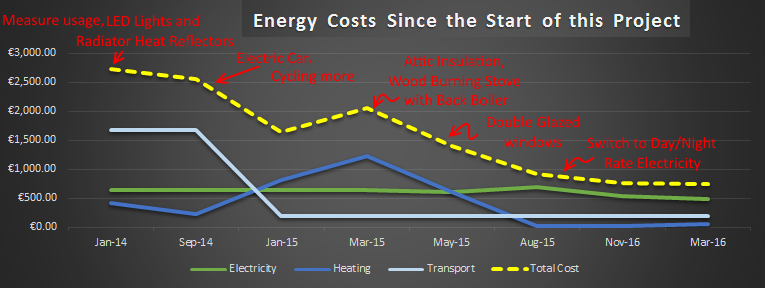
Another way of looking at our energy costs with each component highlighted (electricity, heating, transport):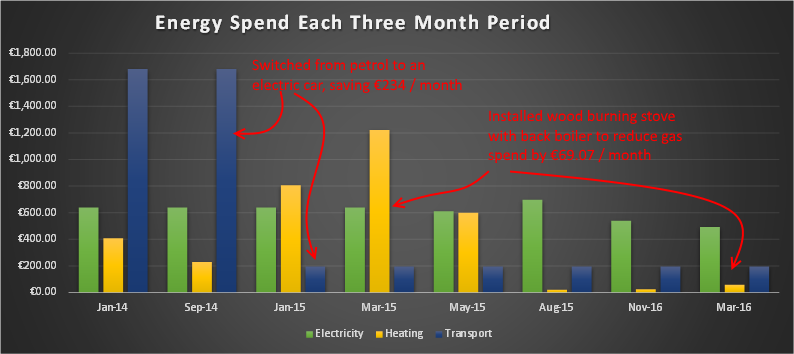
Switching to an electric car took a huge chunk out of our transport costs. It went from costing 246 per month (petrol, tax) down to 24 (electricity). It has been nice having 222 extra in our pockets each month after that. Adding the wood burning stove has also clearly eaten into our gas costs each month. We pay 0.06 per kWh for gas, and about 0.01 per kWh for wood, so each night that the wood burning stove is on and heating the house, we're saving 83% of the cost of heating the house that night. The reduction is pretty clear when comparing March 2015 with March 2016. Switching all of our light bulbs to LEDs is saving 87.29 per year, which is why our electricity bill hasn't increased much when we switch to the electric car, even though it also includes all of our transport costs now too.
Just like when I started this project, at any time, I want to identify the next best investment to make which will save more money than it costs. For this, it makes sense to compare where my money is going on energy (then and now):
January 2014: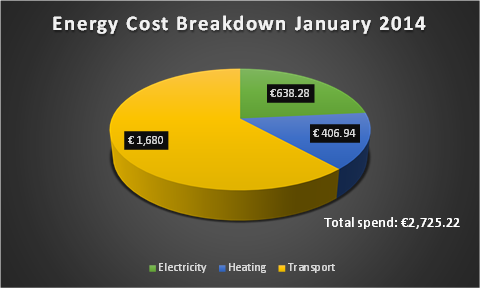
By March 2015, we had eaten into the transport costs by replacing our petrol car with an electric car. The total energy spend run rate was 2,056.75: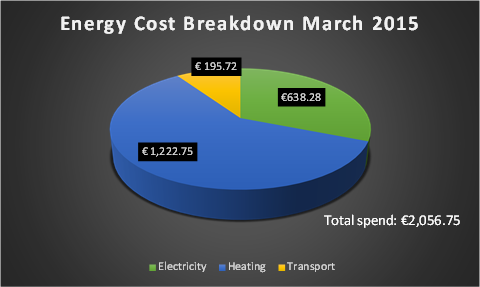
By March 2016, our total energy spend run rate was 745.92: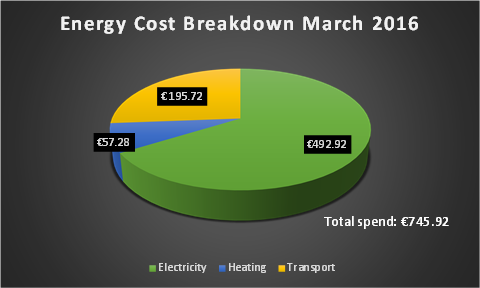
Heating and Transport energy costs are way down. Looking at this chart, It's obvious that our electricity costs are the next target. I believe Solar PV will be the answer to this, to attempt to bring this cost down towards zero. When I started investing in these energy saving projects, I started a direct debit to send the savings our of our current account to a savings account to avoid just flittering away the savings. I increased the Direct Debit each time we invested in a new project - the LEDs, heat reflectors, the wood stove with back boiler and the electric car. That account stands at a few thousand euro now, and it'll be very satisfying to use that to install a Solar PV to eat into our electricity bill.
All in all, progress has been fantastic. Saving 2,000 per year is considerable - given a marginal tax rate of 51% in Ireland, it's the same as getting a raise of roughly 4,100 per year in work. This money has been stacking up to invest in further energy investments, and once our energy costs are down to zero, it's going to stack up in a retirement fund pretty quickly. Also, as of May 2016, the energy savings had resulted in 8,170kg of CO2 not being released into the atmosphere. Eight Tonnes! It shows how a little effort can yield pretty decent results. Most of the investments have also increased our quality of life too - the electric car is both more powerful and much nicer to drive than the previous petrol car, the wood burning stove has literally brought the family together in winter evenings, the energy monitor in the kitchen gives us something to talk about and is a great educational tool for my son for both energy and finance. I'm guessing that the first bit of savings were relatively easy and that getting down to near zero from here will be a lot harder, but nevertheless, this is progress. 2000 a year down, about 800 to go.0 -
Advertisement
-
Great post and very interesting indeed.:)0
-
Good project here, congratulations for taking it on and sharing.
I know this is being done on a cash accounting basis but bear with me.
Few questions, if I may:
Can you share the math on the car from 246 down to 24, your post is silent on the cost per kWh for elec.
I presume you are still charging for free wherever you can and not at home?
How are you arriving at wood costing 0.01/ kWh?
The SEAI see it differently
http://www.seai.ie/Publications/Statistics_Publications/Fuel_Cost_Comparison/Domestic-Fuel-Cost-Comparisons.pdf
Does it include any opportunity cost for the time spent "organising" fuel/ash/etc/etc when compared to gas.
The other point is the differential between the efficiency of the stove versus the gas boiler.
If gas is 6 and the efficiency is 80% then the cost per kWh is 7.5
If the wood is 7.5 as per SEAI and efficiency is 55% then the wood is 13.6
Thanks“I can’t pay my staff or mortgage with instagram likes”.
0 -
No problem. Thanks!Calahonda52 wrote: »Good project here, congratulations for taking it on and sharing.
Sure. I added up all of the costs associated with the running of our petrol car, and an electric car over a year. The petrol car consumed 105.6 litres of petrol per month doing about 300km per week, which came to €2030.56 per year. Maintenance of the petrol car had averaged €1100 per year over the three previous years. Motor tax was €570 per year. On the other side of things: Motor tax on the electric car dropped to €120 per year. The electric car consumes 48kWh per 300km and I charge it at home at night for 7 cent per kWh. So it costs €3.36 per week, or €3.38 * 52 = €175.76 per year versus €2030.56 per year for the petrol car. The electric car has had one service in the two years I've had it so far. The only item listed on the itemised bill was changing of the pollen filter, so I expect maintenance to be quite a bit less. I factor in a replacement of the battery after 5 years into the costs of the electric car. I hope to reuse that battery to store power for our house, though I assume no value in the financial calculations. With all of the costs of both cars totted up, the petrol car cost €3250.56 a year to run, and the electric car costs €295.76 a year to run. That's €270 a month, and €24 a month respectively, which is where the €246 saving a month you mention comes from. The car resulted in a yearly saving of €2954.8, which translates to a 4.1% return on investment of the purchase price of the electric car assuming zero resale value at year 10. That's higher than our mortgage rate, so it made sense to replace our car with an electric car rather than pay down the mortgage. Hence, we bought an electric car. We haven't looked back. There have been many additional benefits in addition to the money - nicer drive, more powerful acceleration, no fumes, in-car technology, etc.Calahonda52 wrote: »I know this is being done on a cash accounting basis but bear with me.
Can you share the math on the car from 246 down to 24, your post is silent on the cost per kWh for elec.
I presume you are still charging for free wherever you can and not at home?
Calahonda52;101982423
How are you arriving at wood costing 0.01/ kWh?
The SEAI see it differently
http://www.seai.ie/Publications/Statistics_Publications/Fuel_Cost_Comparison/Domestic-Fuel-Cost-Comparisons.pdf
Does it include any opportunity cost for the time spent "organising" fuel/ash/etc/etc when compared to gas.The other point is the differential between the efficiency of the stove versus the gas boiler. If gas is 6 and the efficiency is 80% then the cost per kWh is 7.5. If the wood is 7.5 as per SEAI and efficiency is 55% then the wood is 13.6
Firstly, before talking about wood: in the long term, I will install a Heat Pump to heat the house. So if you have the money available, you should skip wood and go straight to a heat pump. It will be the cheapest way to heat your house in the long term compared to gas, oil or wood, particularly when coupled with Solar PV.
Now to answer your question about how I can access wood so cheaply. This will take a post in itself to explain fully, which I have in the works - I prefer to only write a post once I have measured the actual results, rather than predicting them. But in short: I planted trees for firewood, and do the cutting and splitting myself. I don't attribute a cost to the time I spend cutting and splitting because I love doing it. Also, coupled with cycling around the place, it removes the need to pay for a gym and (provided I don't hit myself with an axe at some point!) it will reduce health costs in the future - anything that avoids obesity/diabetes/lifestyle induced health issues seems to save a lot of money in later life. The only cost involved is the transport of the wood, which I do with a few trips in the electric car each year. That comes to €0.01 per kWh. I did a "fun" (I certainly told him it was fun!) experiment to teach my son about energy content to figure this out. (1) Weigh an average log of wood - 800 grams - see attached photo (2) Count the number of logs that go into a fire in one evening - about 12 (3) Multiply the weight of the 12 logs - about 10kg - by the kWh content per kg of wood - 4kWh per kg for dry logs - by the stove efficiency - about 80%. That gives 10kg * 4 kWh / kg * 80% efficiency = 32 kWh per 10kg of wood transported. The trip with 150kg of wood hence transports about 600 kWh of heat energy to the house. That drive costs about €6 (Charging the electric car = €1.68, Buying coffee = about €4), hence 600 kWh / €6 (which is 600 cent) equals €0.01 per kWh of heat delivered to the house.
By the time I've lost the ability to cut and split wood myself, we will have switched to heating the house with Solar PV + a Heat Pump which I believe will be by far the most cost effective method of heating a house.0 -
Good stuff again, thank you!
I asked the questions so as others could benefit as well.
I suspect with the e car that you don't do too many long journeys, so charging at night at home works for you and you don't have any battery recharge syndrome ( or whatever it is called) .
Whats the theoretical range of the e car?
Re the wood pricing, for the ordinary bloke, this financing model is not applicable so my concern here is that folk would pile into wood as they saw on the www that it was 0.01 euro a kWh.
What make is the stove that gives 80% efficiency?“I can’t pay my staff or mortgage with instagram likes”.
0 -
Various models of cars have different ranges on a full charge. I have a 2015 leaf, range is theoretical 150km. Newer models have 250+ range.
What helped me though was that my android phone logs my location history with google history. I was able to look at my maximum journey lengths over a year. At no time had I exceeded that range.0 -
-
Calahonda52 wrote: »Good stuff again, thank you! I asked the questions so as others could benefit as well.
I suspect with the e car that you don't do too many long journeys, so charging at night at home works for you and you don't have any battery recharge syndrome ( or whatever it is called). Whats the theoretical range of the e car?Sir Liamalot wrote: »Range anxiety methinks.
Nissan quote 150km of range for the 2014 Leaf, which is what I have. If you accelerate and brake hard, it'll be more like 120km. Conversely, I've gotten 170km driving it consistently at 70-80kmph on back roads, so about 130-155km is the range you end up with. The 2016 Leaf (30kWh) is stated at around 200-250km, and the 2017 is rumored to have a 60kWh battery, which would suggest a 400-500km range if true. 150km of range has been fine for us. Like most people, most of our driving is commuting or driving around the city. For any two car household, switching one to a second hand electric car would save a considerable amount in running costs. We have just one car, the Leaf, and it's worked fine for us, including longer drives using the public charging network across Ireland.
Range anxiety is just not an issue when you actually start driving an electric car. My best guess is that the media needed something to say about electric cars other than "it's just like driving an internal combustion engine car, but cheaper" and that's where the phrase came from. The car tells you exactly how much battery is left, and how far it will go on it's current charge. You (presumably) know where you are going and how far it is away - so you know before you leave whether you can get there on a given charge or not. While some people have experienced the teething problems with the public charging network for inter-city driving, you can now see in real-time whether charge points are down or occupied, so you can anticipate most problems in advance and plan accordingly. Also - while the faster charging cables come as standard, you can also buy a three pin plug cable for the car. Meaning if worst comes to worse, you can literally be within 250m of a "petrol station" most anywhere in the entire country. But that will probably never happen - get a lend or a test drive of an electric car and try it for yourself. All of the pre-conceptions will disappear within a few days.Calahonda52 wrote: »Re: the wood pricing, for the ordinary bloke, this financing model is not applicable so my concern here is that folk would pile into wood as they saw on the www that it was 0.01 euro a kWh. . What make is the stove that gives 80% efficiency?
. What make is the stove that gives 80% efficiency?
The stove is a Boru 600i - efficiency is stated (by the manufacturer, it must be said) @ 78.8%.
Agreed. For almost everyone, a heat pump will be the cheapest way to heat a house, ahead of wood, gas and oil. A small number may be have the time and space to plant trees like I did, but in the long term, I think a heat pump + Solar PV will beat even the heat energy €/kWh achievable from self-grown firewood.0 -
I am really interested in how you plan to install the heat pump.
My family house was built in 2007 and is well insulated and all of the hot water comes from burning turf in the stove. we have no electric showers (pump showers using the hot water from the stove).
We had an oil burner installed in the shed and insulated pipes going between the house and the shed but it has never been comissioned. I really like the idea of putting the heat pump in instead and giving them the option of using the heat pump to supplement the stove.0 -
-
a lot of great stuff in this thread - thanks for all the work Conor.
a few things that strike me though - changing from gas to wood only makes sense if you have a free supply of wood, and from an environmental perspective I'm not convinced it's any better.
I'm not sure that a heat pump will offer any great savings over gas either, unless you can run it off PV. My electricity unit rate is a little over 3 times my gas unit rate, so if your heat pump is 300% efficient or better (and other threads on here suggest 300 - 350 is realistic), you'll make some small saving, but not much and you'll have to factor in the cost of the pump and installation.
Looking at my gas consumption (for heat, water and cooking) I think I could save ~130 per annum by switching to a heatpump but only if I cancelled my gas account completely. At 3K for heat pump and installation that's a 23 year payback period which isn't great. Adding solar tubes to the mix might improved that but I still don't think it would be worth doing.
Also - and this is obviously going to be a subjective - has the radiator foil made any difference? I've seen it dismissed elsewhere as largely pointless, as radiators work by convection rather than radiation.0 -
Advertisement
-
I'm not sure that a heat pump will offer any great savings over gas either, unless you can run it off PV. My electricity unit rate is a little over 3 times my gas unit rate, so if your heat pump is 300% efficient or better (and other threads on here suggest 300 - 350 is realistic), you'll make some small saving, but not much and you'll have to factor in the cost of the pump and installation.
That's what bothers me too...I have PV panels and a good gas boiler. I can do most of the works as diy. PVs works fine when god Sun is out there .
If I apply your maths and switch off the gas and migrating to electricity... what about the winter and the night times WHEN the demand is higher than day time or sunny summers when PVs works !?? Not so good with all those numbers and COPs and so on. Probable Heat Pump is better when gas supply is not available ,with or without PV panels at all.0 -
That's what bothers me too...I have PV panels and a good gas boiler. I can do most of the works as diy. PVs works fine when god Sun is out there .
If I apply your maths and switch off the gas and migrating to electricity... what about the winter and the night times WHEN the demand is higher than day time or sunny summers when PVs works !?? Not so good with all those numbers and COPs and so on. Probable Heat Pump is better when gas supply is not available ,with or without PV panels at all.
I've seen them marketed as "ideal for properties that are off the gas network" - i.e. they're cheaper than oil or solid fuel options. Geothermal pumps may be a bit more efficient than air pumps.0 -
I would imagine that piped natural gas is the cheapest way to heat your house, unless you have free fuel supply (turf/wood). LPG in a tank would be a different story.0
-
Hi all,
I've been reading this thread a while now and I think it is great.
I currently am trying to get to energy freedom. I took my first step and picked up a Nissan leaf 30kw 6.6kw charge.
I am moving to night rate esb to install for free next week and I will be changing my supplier.
I am looking at this from Nissan https://electrek.co/2016/05/11/nissan-vehicle-to-grid-enel-uk/ the enel vehicle to grid (v2g).
As I have the 30kw battery and only travel 36km round trip I have excess battery capacity.
So what I am looking at is getting the tesla 14kw powerwall2 and plug my car in when I get home.
Obviously the only way this would work is if you can get a full charge in work.
Eventually look to go from piped gas to electric to heat house and water.
Any thoughts?0 -
there's a big discussion on the powerwall elsewhere on boards and the figures don't seem to add up - even if you are charging it from solar PV only, it's still substantially more expensive per kWh than taking your power from the grid.0
-
Tesla is a great solution for "tomorrow", "today" is too expansive as RoI numbers !
Also,im not aware of anything except gas that is more cost effective to heat a house.
Rgds0 -
Tesla is a great solution for "tomorrow", "today" is too expansive as RoI numbers !
Also,im not aware of anything except gas that is more cost effective to heat a house.
Rgds
It really depends. If your house is so well designed and built, such that the heat losses are very small, then electricity starts to make sense because of the very low capital cost of electric heating systems versus a plumbed gas heating system.0 -
So what I am looking at is getting the tesla 14kw powerwall2 and plug my car in when I get home.
Obviously the only way this would work is if you can get a full charge in work.
Eventually look to go from piped gas to electric to heat house and water.
Any thoughts?
So you bought a car with a bigger battery than you need in the hope of recharging it at work at your employers expense in the hope of then using the energy stored in the car battery to recharge a battery in your home?
Have you run this masterplan past your employer at all?0 -
So you bought a car with a bigger battery than you need in the hope of recharging it at work at your employers expense in the hope of then using the energy stored in the car battery to recharge a battery in your home?
Have you run this masterplan past your employer at all?
The employer won't be too worried.
PJ will be in working every day over the winter, even over Christmas, to keep the house heated.0 -
Advertisement
-
Yes, I believe it has. You're right in that most of the heat we feel from radiators are from convection heating of the air around the radiator than the radiation it gives off. Everything above absolute zero gives off radiation, the hotter something is the more radiation it gives off and this radiation heats things it hits, so it definitely makes some difference in terms of reflecting that radiation back from the wall. Whether this difference is meaningful in terms of heating the house is the question. I do actually have a plan to try to measure this scientifically, by training an infrared camara on the house to see how much heat is escaping from areas covered and not covered by heat reflectors. Along these lines:Also - and this is obviously going to be a subjective - has the radiator foil made any difference? I've seen it dismissed elsewhere as largely pointless, as radiators work by convection rather than radiation.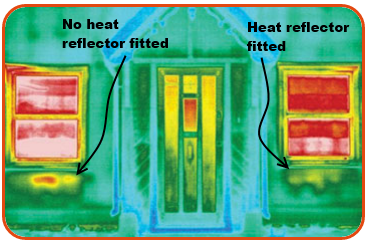
These guys quote a 20% saving a year off heating costs based on academic research from Queen's University in Belfast, among others. But of course they could be selectively quoting in order to sell. So my conclusion thus far is that they do make some difference, and given they also result in subconscious queues when you see them ("Maybe I'll just put on a jumper rather than spending €10 a day keeping the heating at 25C so I can wear a tee-shirt and shorts in January"), I think they are worth doing. Infrared analysis will confirm or disprove this when I get a chance to do it.I am looking at this from Nissan https://electrek.co/2016/05/11/nissan-vehicle-to-grid-enel-uk/ the enel vehicle to grid (v2g). As I have the 30kw battery and only travel 36km round trip I have excess battery capacity. So what I am looking at is getting the tesla 14kw powerwall2 and plug my car in when I get home.[In response to quote above] So you bought a car with a bigger battery than you need in the hope of recharging it at work at your employers expense in the hope of then using the energy stored in the car battery to recharge a battery in your home?
I actually think this isn't as crazy as it sounds. An electric car has a big battery, and big batteries can be used to power anything. Lots of utilities are already looking at how they could pay EV owners money to access some percentage (say, 20%) of the battery while it's plugged in to the house to power the grid en-masse as a way to ensure grid stability and remove more expensive power plants. So I'm not about using as a way to siphon off electricity from my employer (!) but if I try to get to PV + Batteries, and disconnect from the grid entirely, the electric car is basically the backup plan if there is no sun for a few days - drive it to a nearby charger, charge it and plug it back into the house to power the house / charge on site batteries. New EVs are coming with 30-80kWh batteries. A house consumed maybe 10-20kWh a day, so the car could conceivably power the house for several days with this setup.I am really interested in how you plan to install the heat pump. My family house was built in 2007 and is well insulated and all of the hot water comes from burning turf in the stove. we have no electric showers (pump showers using the hot water from the stove).
We had an oil burner installed in the shed and insulated pipes going between the house and the shed but it has never been commissioned. I really like the idea of putting the heat pump in instead and giving them the option of using the heat pump to supplement the stove.
Yep, certainly sounds like you're a good candidate for a heat pump.I will realy appreciate some magic that you do with numbers and graphs and formulaes.. Can you do a "thing" comparing gas boilers VS heat pumps please !? With and without the PV panels. ThanksEventually look to go from piped gas to electric to heat house and water.A lot of great stuff in this thread - thanks for all the work Conor.
a few things that strike me though - changing from gas to wood only makes sense if you have a free supply of wood, and from an environmental perspective I'm not convinced it's any better. I'm not sure that a heat pump will offer any great savings over gas either, unless you can run it off PV. My electricity unit rate is a little over 3 times my gas unit rate, so if your heat pump is 300% efficient or better (and other threads on here suggest 300 - 350 is realistic), you'll make some small saving, but not much and you'll have to factor in the cost of the pump and installation. Looking at my gas consumption (for heat, water and cooking) I think I could save ~130 per annum by switching to a heatpump but only if I cancelled my gas account completely. At 3K for heat pump and installation that's a 23 year payback period which isn't great. Adding solar tubes to the mix might improved that but I still don't think it would be worth doing.
Some very good questions to get the ball rolling on heat pumps, thanks! Sure. I'm currently in research mode looking into the next step, and I will do this as part of that research. For the next investment (actually reinvestment, of savings from previous investments, particularly the electric car), I'm weighing up Battery Storage or a Heat Pump. Each have their merits. Battery storage provides a way to store excess Solar PV in summer, and to store cheap night rate electricity (€0.05 / kWh) in winter to remove daytime electricity costs (~€0.16 / kWh) - like PV, prices are falling rapidly, though it is still probably on the expensive side. A heat pump would allow us to heat the house fully with electricity, meaning we can generate it ourselves at a fixed price per kWh no matter what gas / oil markets do, remove our gas connection and it's costs completely, and obviously remove our gas bills.
Loyatemu, your question got me thinking about how to calculate this for everyone's different scenario rather than just one. Your figures look about right. Just doing some maths on the spot, converting the M^3 rate for gas into €/kWh, looking up the standard gas, electricity and oil costs from the SEAI here, and using my own house's heating load for 2016, here are some (very!) back of the envelope cost comparisons:
For the year of 2016, our house required 19,898kWh of heating. The various costs for this would be:- Gas: 19,898 kWh * €0.0652 = €1,297.35
- Oil: 19,898 kWh * €0.0710 = €1,412.76
- Heat Pump (with 300% efficiency, with night rate electricity @ €0.05 / kWh): 19,898 kWh / 300% efficiency = 6,632.6667 kWh * €0.05 = €331.63
- Heat Pump (with 300% efficiency, half with excess PV @ €0.00 / kWh and half with night rate electricity @ €0.05 / kWh): ( (19,898 / 300% efficiency = 6,632.6667 / 2 = 3,316.3334 ) * €0.00 = €0.00) + ( (19,898 / 300% efficiency = 6,632.6667 / 2 = 3,316.3334 ) 3,316.3334 * €0.05 = €165.82) = €165.82 (the assumption in here around the split between excess PV and night rate here is tricky - most excess PV will be in summer when there is little heating requirement, so this figure will fall somewhere between €165.82 and €331.63, so let's take the average €165.82 + €331.63 = €497.45 / 2 = €248.73 ).
Assuming installation costs of: Gas (€2000), Oil (€3500), Heat Pump (€4000) and Heat Pump plus PV (€7000), coupled with their yearly running costs above for 15 years gives me this chart: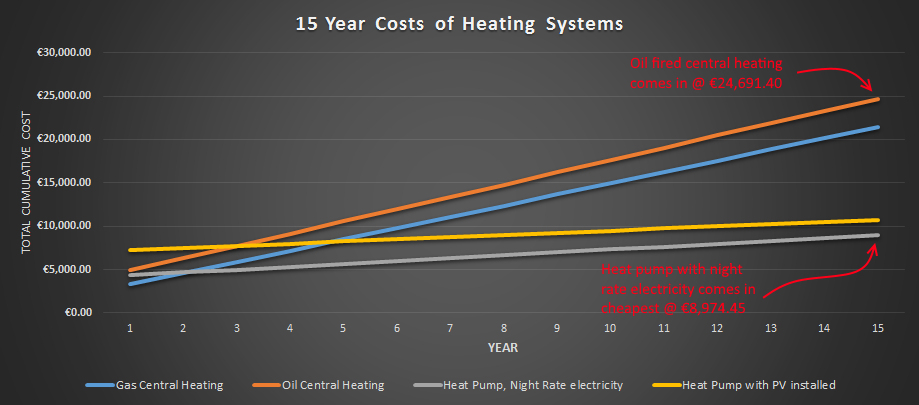
Total 15 year costs including installation come to:- Gas Central Heating: €21,460.25
- Oil Central Heating: €24,691.40
- Heat Pump, Night Rate electricity: €8,974.45
- Heat Pump with PV: €10,730.95
The installation costs are rough estimates - I haven't installed these before so I'm not sure. But you could re-do the chart above yourself based on your own installation costs and heating requirements to figure out what is cheapest for you over the 15 years.
Oil and gas prices taken from here. If the Heat Pump is 300% efficient, it takes 19,898 kWh of heat / 3 = 6,632 kWh of electricity to pump in 19,898kWh of heat energy into the house.0 -
Surely they meant 2%? Deliberate mistake on their part?These guys quote a 20% saving a year off heating costs based on academic research from Queen's University in Belfast, among others. But of course they could be selectively quoting in order to sell. 0
0 -
Do you have underfloor heating or radiators? If rads you're not going to be able to heat your house by running the HP at night time only.
Also watch out for how the COP varies with outside temperature. A COP of 3 might be based on outdoor temp of 12C or similar, at which point you don't need much heating, can drop much lower when its properly cold and then you're more expensive than gas or oil0 -
Conor20 Great posts. Really enjoy them.
Just to let you know that i've a 20 year old bungalow. Purchased 3 years ago with below average insulations and terrible heating.
To date:
Replace all lights with LED (3 years ago)
Wood burning stove (non back boiler) in main sitting/kitchen area (3 years ago
Pumped Cavity with ecobead (2 years ago)
Another 200mm rockwool into attic, cross rolled over existing (2 years ago)
Attic hatch doors are now insulated. (1 year ago)
Old firebird boiler and cylinder with immersion ripped out and replaced with Air To Water heat pump. New cylinder to match heat pump. (3 months ago). Last month it cost me 80 euro for all my heating and hot water.
4k won't cover you to install a new heat pump unless you are willing to go cheap and cheerful. I'm in the trade so i installed it myself.
Next plans are PV panels and a Powerwall. I can't see the benefit to PV unless i can sell the excess or store it for later use.
Also the house will be gutted in 5 years if herself as her way so will do new windows and air tightness then.
I can't tell you payback and how much i'll save but i've cheap hot water in the taps and a constantly warm house.0 -
Conor20 Great posts. Really enjoy them.
Just to let you know that i've a 20 year old bungalow. Purchased 3 years ago with below average insulations and terrible heating.
To date:
Replace all lights with LED (3 years ago)
Wood burning stove (non back boiler) in main sitting/kitchen area (3 years ago
Pumped Cavity with ecobead (2 years ago)
Another 200mm rockwool into attic, cross rolled over existing (2 years ago)
Attic hatch doors are now insulated. (1 year ago)
Old firebird boiler and cylinder with immersion ripped out and replaced with Air To Water heat pump. New cylinder to match heat pump. (3 months ago). Last month it cost me 80 euro for all my heating and hot water.
4k won't cover you to install a new heat pump unless you are willing to go cheap and cheerful. I'm in the trade so i installed it myself.
Next plans are PV panels and a Powerwall. I can't see the benefit to PV unless i can sell the excess or store it for later use.
Also the house will be gutted in 5 years if herself as her way so will do new windows and air tightness then.
I can't tell you payback and how much i'll save but i've cheap hot water in the taps and a constantly warm house.
Are you running Rads of your heat pump?0 -
Next plans are PV panels and a Powerwall. I can't see the benefit to PV unless i can sell the excess or store it for later use.
there's been some discussion of the Powerwall on this forum, it seems that given the price and the limited number of charge/discharge cycles it doesn't make a lot of financial sense at present (unless you want/have to go off grid).0 -
Advertisement
-
-
-
Conor20 Great posts. Really enjoy them.
Just to let you know that i've a 20 year old bungalow. Purchased 3 years ago with below average insulations and terrible heating.
To date:
Replace all lights with LED (3 years ago)
Wood burning stove (non back boiler) in main sitting/kitchen area (3 years ago
Pumped Cavity with ecobead (2 years ago)
Another 200mm rockwool into attic, cross rolled over existing (2 years ago)
Attic hatch doors are now insulated. (1 year ago)
Old firebird boiler and cylinder with immersion ripped out and replaced with Air To Water heat pump. New cylinder to match heat pump. (3 months ago). Last month it cost me 80 euro for all my heating and hot water...
i've cheap hot water in the taps and a constantly warm house.
Really interesting (and inspiring), thanks! I'd be really interested to hear how much the whole heat pump installation cost you, and the full list of work undertaken to install it. Did you install underfloor heating for example, or do you just use the rads to transfer the heat?Next plans are PV panels and a Powerwall. I can't see the benefit to PV unless i can sell the excess or store it for later use.
I will have all of the maths on this late in the coming summer. In October, we installed a 2.2kW PV array on the roof of the house. I based the evaluation for the investment on data from the free solar PV modelling tool here: http://pvwatts.nrel.gov/pvwatts.php . It takes your location and uses weather data to estimate how many kWh a PV system will generate for your house on average each month and each year. The initial results are good. The generation we've gotten so far matches the monthly estimates spot on, so the calculation of ~7.5% yearly ROI is on track (much better than paying down the mortgage @ 3.5%). I will wait for several more months before publishing the full data and analysis here, when I have observed results covering both the winter trough and the summer peak generation, but the initial data suggests that it does make financial sense to install PV, at least for our usage profile, even without battery storage. Obviously, a lot will depend on your usage profile, which determines how much consumption you can offset with PV generation. Results to follow!
As you note, battery storage will remove the need to have any specific usage profile, so sorts all of this out. As soon as their €/kWh price over their usable lifetime drops below the €/kWh arbitrage spread between PV generation (€0.00 / kWh), night rate (~€0.07 / kWh) and day rate (~€0.17 / kWh), they'll make financial sense to install. The direction of battery storage costs per kWh over the last few years (coming down, and fast) says that this point will inevitably come - possibly sooner rather than later depending on how the Tesla Gigafactory and other similar operations impact the market. We just have to wait a bit. In the meantime, PV may make sense without battery storage if, like is the case for us, you can use enough of the generation in the form of electricity, hot water or otherwise.0 -
there's been some discussion of the Powerwall on this forum, it seems that given the price and the limited number of charge/discharge cycles it doesn't make a lot of financial sense at present (unless you want/have to go off grid).
Discussion on these forums was around the original Powerwall. The figures did not make pretty reading however the Powerwall 2 figures are a lot better. Not quite there yet but not far off.0 -
I see the figures there for kwh of heating for a year. Interested have you done the same for electricity usage at all? What's your annual electricity consumption?
We are a household of 5 people, average electricity usage 7100 kwh per year (averaged over 3 years), averaged at 9.49 units on day, 9.29 units on night rate. Electric showers are our big drain at the moment I suspect, projected to increase as our children get older.
Finding it tricky to decide between installing PVs or solar tubes (and converting electric showers to pumped hot water.) I have worked out our PV savings profile... looking at a saving of about 1200kwh in electricity for our roof space. But I'm not happy with data on my projected saving on oil, because there's such a huge variant year on year with oil prices, and as it's a tank that gets refilled on an ad hoc basis,
Wondering if our electricity usage is high though, for 5 people... Has anyone got data on that?
I see 3000kwh per year for average household being bandied about, but the average household is between 1 and 2 people as far as I know.0 -
Advertisement
Advertisement